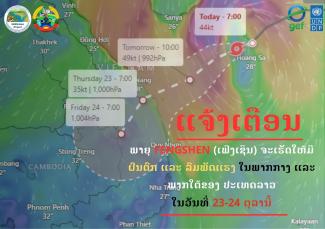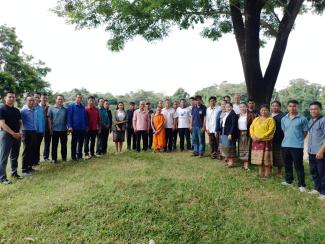Formulating Local Regulations for Water Conservation Zones in Savannakhet Province
The Department of Water Resources (DWR) under the Ministry of Agriculture and Environment (MOAE), in partnership with UNDP Lao PDR, successfully carried out field consultations and technical missions in Savannakhet Province as part of the Integrated Water Resources Management and Ecosystem-based Adaptation (IWRM–EbA) Project. This initiative, supported by the Global Environment Facility (GEF), focuses on strengthening the resilience of communities and ecosystems in the Xe Bang Hieng River Basin, one of the country’s most important and dynamic river systems.
The ten-day mission involved extensive community engagement, technical discussions, and validation activities with provincial, district, and village-level authorities. The main objective was to develop and finalize local regulations for four designated water conservation zones in Sopsalou, Kaengthamae, Nongvilai, and Saveu Villages. These conservation areas are critical for ensuring sustainable use of water resources, preserving biodiversity, and mitigating the impacts of floods and droughts that increasingly threaten rural livelihoods.
Key Achievements and Outcomes:
Demarcation and Verification of Conservation Boundaries:
The team completed the mapping and physical demarcation of the Saveu Village water conservation zone, confirming the zone’s boundaries through participatory verification with local authorities, village leaders, and residents. Using participatory mapping tools, local stakeholders actively identified key ecosystem areas such as headwaters, riparian forests, and wetlands that are vital for maintaining water flow and quality.
Community Consultations and Draft Regulation Development:
Consultative meetings were organized across all four target villages to collect community inputs and feedback on the draft water conservation regulations. These sessions encouraged open discussion about resource use, restrictions, and enforcement mechanisms. The resulting draft regulations align with the Lao Water Law (2017) and reflect a balance between conservation needs and community livelihoods.
Strengthening Local Awareness and Ownership:
Through participatory dialogues, villagers gained a deeper understanding of the importance of sustainable water and forest management. The consultations helped clarify responsibilities for local monitoring, reporting, and compliance—ensuring that communities play a central role in safeguarding their own natural resources.
Integration of Traditional Knowledge:
The process also emphasized the inclusion of indigenous knowledge and traditional practices related to water use, forest protection, and spiritual forest zones. Elders and local leaders shared long-standing customs that have helped preserve the ecosystem, which are now being incorporated into the formal community regulations.
Multi-Stakeholder Coordination:
The mission brought together representatives from the Provincial Department of Natural Resources and Environment, the District Agriculture and Forestry Office, village authorities, and community organizations. Their collaboration reflects a shared commitment to integrated water governance and sustainable resource management in line with national environmental policies.
Supporting a Climate-Resilient Future
The development of local regulations for water conservation zones is a key milestone in the IWRM–EbA Project’s goal to enhance climate resilience and ensure the long-term sustainability of water resources in the Xe Bang Hieng River Basin. By establishing clear legal and institutional frameworks, local communities can effectively manage critical water ecosystems that provide drinking water, irrigation, and habitat for biodiversity.
This participatory and inclusive approach also ensures that women and youth are actively engaged in decision-making, reflecting the project’s commitment to gender equality and inclusive governance. During the consultations, community representatives shared practical solutions for managing seasonal droughts, restoring degraded forests, and reducing pollution from agricultural activities.
“This activity demonstrates the importance of participatory governance in managing natural resources,” said a representative from the Department of Water Resources. “By working closely with local authorities and communities, we ensure that regulations are realistic, locally owned, and effectively implemented to protect our shared environment.”
Representatives from UNDP Lao PDR also highlighted the project’s contribution to Lao PDR’s national strategies on water resource management, climate change adaptation, and ecosystem restoration. The mission exemplifies how local action, guided by national policy and supported by international cooperation, can deliver meaningful progress toward achieving the Sustainable Development Goals (SDGs).
Next Steps:
Following this field mission, DWR and UNDP will work with local authorities to finalize and endorse the regulations, establish community monitoring committees, and provide capacity-building support to ensure effective implementation. Awareness materials and training modules will be developed to assist communities in enforcing the rules, maintaining data on ecosystem health, and reporting water quality and usage.
The success of this initiative reinforces the power of collaboration, community engagement, and science-based planning in advancing sustainable water and forest management. By protecting these vital ecosystems today, Savannakhet’s communities are paving the way for a more resilient and sustainable future for generations to come. 🌿💧
Latest Highlights

Tropical Cyclone FENGSHEN is moving westward at 20 km/h and is expected to affect central and southern Laos on October 23–24, 2025. The storm may bring heavy to very heavy rainfall, strong winds, flash floods, and landslides in several provinces, including Vientiane Capital, Xaysomboun, Vientiane, Bolikhamxay, Khammouane, Savannakhet, Saravan, Sekong
From 12–22 October 2025, the Department of Water Resources (DWR), Ministry of Agriculture and Environment (MOAE), in collaboration with UNDP Lao PDR, conducted a series of field consultations, coordination meetings, and participatory mapping exercises in Savannakhet Province. The mission aimed to develop and validate local regulations for four community-managed water

Nong District has launched a major conservation initiative in Nong Wilay and Tang Alai Nuea villages to protect aquatic biodiversity in the Xe Lanong River. The project establishes clear reserve boundaries, permanent signage, management regulations, and local committees, empowering communities to sustainably manage aquatic resources and preserve natural ecosystems

ເມືອງນອງ ໄດ້ຈັດຕັ້ງປະຕິບັດຂໍ້ລິເລີ່ມການອະນຸລັກທີ່ສຳຄັນ ຢູ່ບ້ານນອງວິໄລ ແລະ ບ້ານຕັ້ງອາໄລເໜືອ ເພື່ອປົກປັກຮັກສາຊີວະນາໆພັນສັດນ້ຳໃນແມ່ນ້ຳເຊລຳເຊ. ກິດຈະກຳໄດ້ກໍານົດຂອບເຂດສະຫງວນທີ່ຈະແຈ້ງ, ປ້າຍຖາວອນ, ລະບຽບການຄຸ້ມຄອງ, ແລະຄະນະກໍາມະການທ້ອງຖິ່ນ, ສ້າງຄວາມເຂັ້ມແຂງຊຸມຊົນໃນການຄຸ້ມຄອງຊັບພະຍາກອນນ້ໍາແບບຍືນຍົງແລະປົກປັກຮັກສາລະບົບນິເວດທໍາມະຊາດ.
